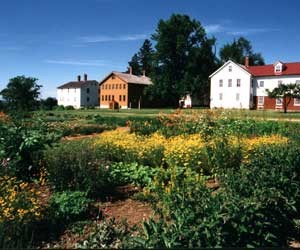For groups looking to take a step back from the high-tech world of texting, tweeting, blogging and other addictions, the East Coast is chock full of well-preserved, historic enclaves that hearken back to another era. Many offer intriguing venues as well as opportunities for out-of-the-ordinary team-building activities.
Old Sturbridge Village, Mass.
Old Sturbridge Village (www.osv.org), the largest outdoor history museum in the Northeast, illustrates early 19th century life in a rural New England town. Visitors are invited into more than 40 original buildings, each brought to the museum site from towns throughout New England, including homes, meeting houses, a district school, country store, bank, law office, printing office, carding mill, sawmill, gristmill and blacksmith shop.
Costumed interpreters carry out the daily activities of an early 19th-century community, portraying farmers, school teachers, potters, blacksmith and others. For visitors, the village offers a variety of hands-on options, such as candle making and pottery.
“People today don’t want to just watch an exhibit, they want to experience and try for themselves,” says Ann Lindblad, director of communications for Old Sturbridge Village. “It’s a very rich experience. We can tailor a corporate meeting around their needs”
Educational options include lectures from historians and behind-the-scenes tours of artifacts not on display to the public. Sturbridge is home to over 60,000 artifacts, including clothing for the interpreters. Private tours with an historian are also available.
“One of our newest exhibits is a rolling one,” says Lindblad, referring to an authentic reproduction of an old stagecoach. “In our time period, stagecoaches criss-crossed New England. Visitors can ride the stagecoach to see what it’s like, feel how bumpy it was."
The village also offers activities such as a giant tug-of-war on the village common, suitable for a team-building event. Another activity guests can play is 1830-style baseball.
“At that time they used to bat using an ax handle and they ran the bases clockwise," Lindlblad says. "People can try it, historians are there explaining the rules; it’s always good for laughs.”
One of the most popular functions is a dinner at a historic home in a country village, when small groups of 14 can experience how a meal was made over the fireplace. Historians teach participants how to cook the food themselves, whether roasting meat over a fire or baking pies in a beehive oven.
Lancaster County, Pa.
Lancaster County (www.padutchcountry.com) is renowned as America's oldest Amish settlement, home to about 16,000 Amish still living a centuries-old "Plain" lifestyle. Many Amish-themed attractions, events, foods and crafts are available in the region.
The town of Lancaster itself offers the most hotel and meeting space options for groups, including the Lancaster County Convention Center, and also serves as a starting point for learning about Amish life.
"Everybody in our region knows Lancaster—they have seen the movie Witness,” says Chris Barrett, president and CEO of the Pennsylvania Dutch CVB.
Groups can visit the Amish Farm and House, an 1805 farmhouse formerly occupied by an Amish family. Guides explain the Amish history, clothing, customs and culture as displayed in the various rooms of the home. The property spans 15 acres replete with a variety of farm animals, historic barns and exhibits such as a blacksmith shop and tobacco stripping room. There are also people demonstrating crafts such as a resident carver and a quilter.
The Lancaster Quilt & Textile Museum also shows off the Amish quilt, an art form that dates to 1849 in Lancaster County. The Beaux Arts building can host group functions.
Downtown's Central Market, one of the country's oldest farmer's markets, displays Amish-based foods and crafts. Another historic spot, the 1719 Hans Herr House, stands as the oldest structure and the oldest Mennonite meeting house in Lancaster County. Groups can discover early colonial and Mennonite history and culture through the exhibitions.
Also available to groups is the Fulton Theatre, the oldest continuously operating theater in the country.
"Lancaster has so many older structures like tobacco warehouses that were converted into venues," Barrett says. "The Cork Factory Hotel is set in an old cork factory [built in 1865 for Lancaster Cork Works]. The Lancaster Arts Hotel was an old tobacco warehouse."
South of Lancaster, Ronks is known for its Amish Village, offering guided tours through an 1840s farm house furnished as a typical Lancaster County Old Order Amish house. The grounds include a barn with farm animals, operating water wheel, blacksmith shop and a smoke house with Pennsylvania Dutch foods. Amish buggy rides are also available in Ronks.
The nearby Strasburg Railroad is one of the oldest shoreline railroads in the U.S.
"Guests can lease a car and be served a meal," Barrett says. “The excursion is 10 miles out and back. The car is very cool."
Also in Strasburg, Hershey Farm Restaurant & Inn offers a number of group experiences, such as learning how to make shoofly pie, a regional staple.
"Cooking demonstrations are huge here. A lot of groups seek that out,” Barrett says.
Amish-style dining experiences are available throughout the county, with well-known spots like Good ‘N Plenty, in Smoketown, serving a family-style meal with items traditional for the area. Groups can reserve the entire restaurant.
Tarrytown/Sleepy Hollow, N.Y.
Situated on the eastern shore of the Hudson River, in an area called the Tappan Zee, Tarrytown (www.hudsonvalley.org) is just 25 minutes from New York City. A signature event in its history happened during the Revolutionary War. On September 23, 1780, three local militiamen captured a British spy, Major John Andre, who was carrying papers describing the fortification of West Point, given to him by Benedict Arnold.
North Tarrytown was immortalized in Washington Irving’s tale, The Legend of Sleepy Hollow, and was later renamed Sleepy Hollow. Known as the “Millionaire’s Colony,” the area grew into a haven for rich industrial magnates such as Anson Phelps Stokes, Ambrose Kingsland and John D. Rockefeller. Some of the mansions they built are open to the public.
Both Tarrytown and neighboring Sleepy Hollow are filled with historic properties and sites. Close to Tarrytown is Sunnyside, the home of Washington Irving.
"It's a great time piece from mid 1800s,” says Rob Schweitzer, director of public relations for Historic Hudson Valley, a private nonprofit that promotes six Hudson Valley historic sites. “It’s charming and very unusual. It really speaks to that romantic period in American culture. The landscape was designed by Irving, a wild landscape that has been preserved by our organization. Groups can use the grounds, have cocktail parties on the lawn and take tours of the house.”
Philipsburg Manor in Sleepy Hollow was originally the seat of a commercial empire that covered all Westchester County. The manor was maintained by African American slaves and today is used to tell the story of slavery in the colonial north. Interpreters in period costume offer tours of the house and lead guests in hands-on activities, such as shelling beans and working flax into linen.
On site, the Greenhouse is open to groups, offering space for stand-up events. The adjoining Gallery, decorated with artifacts from the collection of Historic Hudson Valley, is a larger setting suitable for formal dining.
Near Tarrytown, the Van Cortlandt Manor is an important Revolutionary-era estate, set between the Hudson and Croton Rivers in a wooded area. Meetings can include a tour of the site or an interactive demonstration with a costumed guide on 18th or 19th century crafts, such as textiles, woodworking or candle making.
Canterbury Shaker Village, New Hampshire
The Shakers emigrated to the U.S. in 1774 and eventually established 19 self-contained communities from Maine to Kentucky. Canterbury Shaker Village (www.shakers.org), established in 1792, is one of the oldest and most completely preserved of the Shaker settlements.
Canterbury interprets 200 years of Shaker life through its exhibits, buildings, gardens, programs and tours. The museum consists of 25 restored and four reconstructed Shaker buildings. Its 694 acre site includes gardens, fields, ponds and forests.
"We're the only Shaker village sanctioned by Shakers to be run as a museum,” says Deirdre Jordan, marketing manager for the Canterbury Shaker Village.
Highlights include the only intact, first-generation Meetinghouse, built in 1792, and Dwelling House, built in 1793, in their original locations.
"Our covenant with the Shaker Sisters when they passed away does not allow anyone to dress up as characters," says Jordan.
Points of interest include the Carriage House, which showcases rotating exhibits of Shaker hand-made crafts. Also open is the Infirmary, where Shakers would come for medical attention or to spend their final days, and where they did their embalming. Other buildings include the beekeeping house, the Sister’s Shop where they did spinning and weaving and the Meetinghouse where they worshipped.
A tour takes visitors through the Shaker’s life and religion.
"This year we're adding garden tours—we're restoring historic gardens to the way they were when the Shakers were here," Jordan says.
Groups can arrange tours of the museum and also host catered affairs. The on-site restaurant accommodates groups on its main restaurant level or third floor, which is set aside for functions. Each space holds up to 70 dinner guests. In summer, the patio opens up for larger groups.
Other buildings open to groups include the North Shop, a barn decked out with linens and tablecloths for up to about 100 people. The Garden Barn near the ponds holds 40 people. Groups can also rent out the lawn space by the Garden Barn and set up a tent for up to 150 people. There is even a classroom at the village open to groups.







